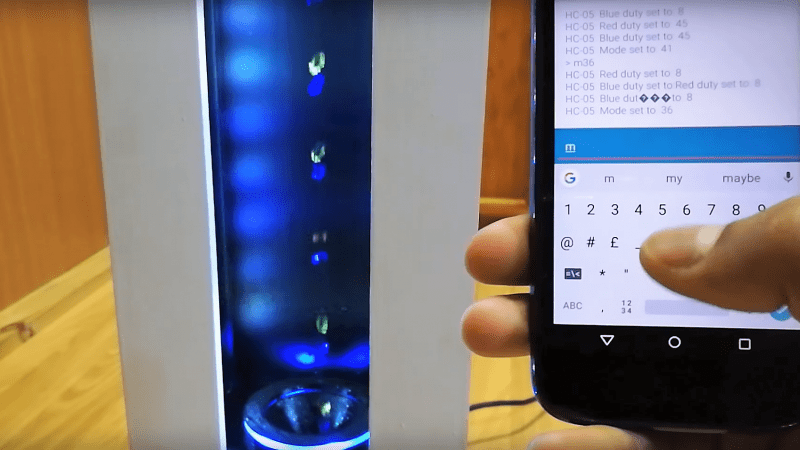The 60s and 70s were a great time for kitschy lighting accessories. Lava lamps, strobes, color organs, black light posters — we had it all. One particularly groovy device was an artificial rain display, where a small pump dripped mineral oil over vertical monofilament lines surrounding a small statue, with the whole thing lighted from above in dramatic fashion. If it sounds appalling, it was, and only got worse as the oil got gummy by accumulating dust and debris.
While this levitating water drops display looks somewhat similar, it has nothing to do with that greasy lamp of yore. [isaac879]’s “RGB time fountain” is actually a lot more sophisticated and pretty entrancing to watch. The time fountain idea is simple — drip water from a pump nozzle to a lower receptacle along a path that can be illuminated with flashing LEDs. Synchronizing the flashes to the PWM controlling pump speed can freeze the drops in place, or even make them appear to drip up. [isaac879] took the time fountain idea a step further by experimenting with RGB illumination, and he found that all sorts of neat effects are possible. The video below shows all the coolness, like alternating drops of different colors that look like falling — or rising — paint drops, and drops that merge together to form a new color. And behold, the mysterious antigravity cup that drips up and yet gets filled!
Allowances must be made for videos of projects that use strobes, of course. The effect of this time fountain and similar ones we’ve featured before is hard to capture, but this one still looks great to us.
Thanks to [xamiax] for the tip.
















Very pretty
very impressive
Very cool.
I know someone who has one of the nicer ones. Rarely uses it.
That is very neat – I want one
I don’t want to be negative… but what slightly annoys me on this project (and lot’s of projects that look work like this ) is the fact that the video has no audio. The video and presentation look nice and polished… the maker even remarks that the quality of the video is poor due to the fact of framerate differences, rolling shutter blablabla. But completely ignores that fact that you can’t hear the machine. Though I understand as it would ruin the video.
It looks pretty… but you don’t want this in your room… the sound of the pump and droplets would make you mad or drive you insane and most likely would increase your daily number of visits to the toilet.
These kind of things look nice in noisy train stations or airports… not at home.
What would make this project practical is to combine it with a cat fountain. Because cats would love to drink from moving water sources. Combined with a sensor that makes it work when the cat comes close could improve functionality. Though, the water needs to be replaced every day and some other forms of cleaning do need to take place on a regular basis. We don’t want the cat to get sick from bacteria forming in the pump and hoses.
The sound of the pump should not be that big of an issue. It needs a very low flow rate anyway, and adding some kind of noise dampening media below and all around the pump is easy to do because you have enough space for something like that in the cabinet.
As for the sound of dripping water (that makes you want to pee aparently), again, this is very easy to eliminate if you actually design your bottom funnel in a smart way. Should not be too hard because he uses a 3D printed design anyway to stop the spilling of water droplets everywhere.
…should…could… sure…. but we never know because the video has no sound.
I totally agree that sound can be reduced to very low levels… but never to zero. And in a quit room (imagine yourself reading a book or studying late at night… then you will agree that even low noise levels can be very distracting. Especially the ones that are continuous/repeating.
Anyway… we never know because the video has no sound.
This one has sound:
https://www.youtube.com/watch?v=d_UaWV3wQsc
! ! e m o s e w a
Maybe just sense the drip and use that to set the speed of the strobe. Then you’ve only got to trim it as you would with pwm.
Link?
The link in the article seems to go to a github only containing the .ino file. Is there no writeup about how it was constructed; what kind of pump is dropping the water, what it’s made from, how the LEDs are mounted?
IMO the code is trivial, a variable LED strobe, adding a bit of an LED chaser effect doesn’t add much complexity. It’s the mechanical part of a build like this that’s interesting, and it’s where all the work is in creating a lovely art piece.
Watch the video…
imho you could totally productize this
It’s already productized into something even better:
https://www.kickstarter.com/projects/northerncircuitsinc/aquarius-a-water-manipulating-fountain-lamp